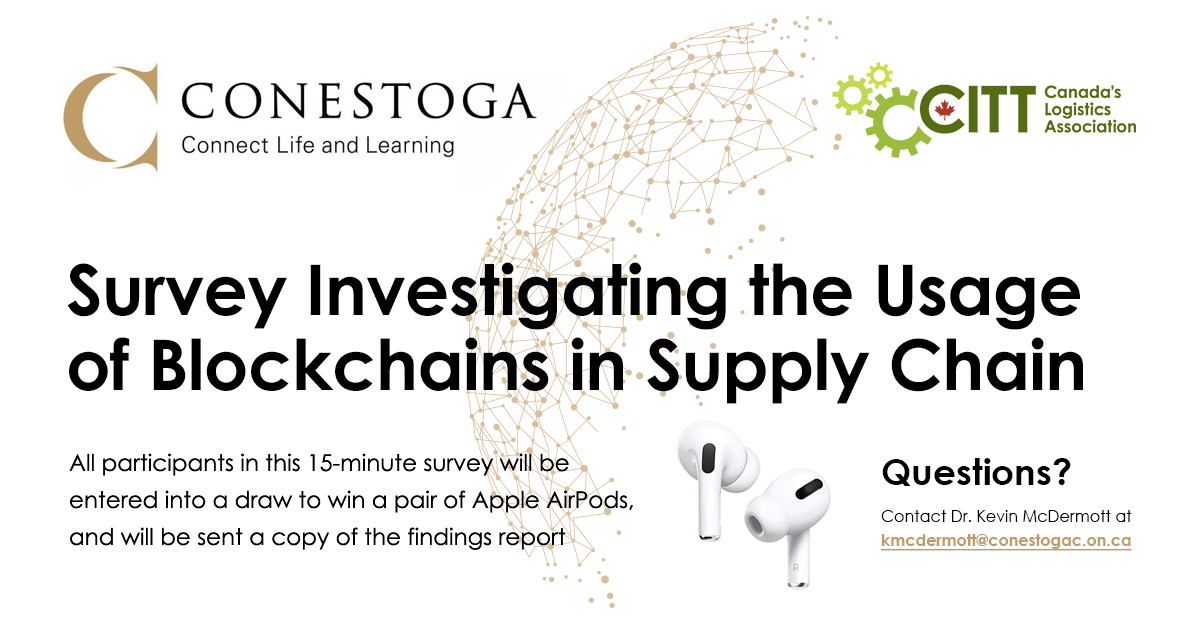Blockchain in Supply Chain Adoption 2023 – Key Context and Survey Now Open
We sat down with Kevin McDermott, professor in the School of Business at Conestoga, and Erik Valiquette, President of the Canadian Blockchain Supply Chain Association to discuss the 3rd annual survey on usage of blockchain in supply chain - and the implications of the results.
Ready to participate in the survey on blockchain adoption in supply chain? Click here!
What was once a buzzword in our industry, blockchain technology has matured beyond infancy and entered something of an adolescent phase. Certainly, there is much to be learned and explored in terms of how blockchain will impact shipping moving forward, but as a technology, many of the basic ways in which it can be used are beginning to see more widespread adoption.
From compiling data shipping containers, to speeding up supply chains or helping remove middlemen from complicating how we get SKUS form point A to B, the power of blockchain is making itself known.
To better understand how it works and what its impact will be, CITT is pleased to announce what has become an annual event—our 3rd annual blockchain survey. Held in partnership with Conestoga College, this survey will help uncover all the practical ways people in our industry are using it the technology, to identify trends and help blockchain mature even further.
The value of an annual blockchain survey
As part of this year’s launch, we sat down with Kevin McDermott, professor in the School of Business at Conestoga, and Erik Valiquette, President of the Canadian Blockchain Supply Chain Association, to hear what they had to say about the importance of the survey.

Kevin McDermott
Professor, School of Business
Conestoga College

Erik Valiquette, CCLP
President
Canadian Blockchain Supply Chain Association
Year-over-year data collection
According to Professor McDermott, the value of an annual survey into blockchain is to provide an ecosystem of data Canadian supply chain companies can use to make strategic decisions.
“Multiple years of data is very important”, he said. “The reason why we like to see data over time is that it can indicate whether blockchain is being used more in Canadian supply chains, or if the understanding of how blockchain can help organizations, is going up or going down.
In isolation, a single year’s data point does not allow strategic decision makers within organizations to make policy decisions. [Doing the survey] for three years is important because it validates whether trends in how it is being used are continuing upwards or downwards."
Improved awareness
The importance of being able to verify trends in blockchain usage was echoed by Mr. Valiquette. He also stressed that by understanding specific use cases, another factor covered by the survey, all organizations better understand how they could benefit from using blockchain.
“On top of looking at the trends and patterns, examining specific use cases can help other organizations identify how they might use blockchain. It gives the technology improved visibility, which can in lead to companies using it to increase their competitiveness or improve their operations.”
Valiquette also pointed out that thanks to the survey, we know that the sentiment above isn’t just anecdotal. He explained:
“One of the interesting things I think we saw last year was between our first year during the survey and the second year doing the survey, we saw an increase in the percentage of people familiar with blockchain go up from 48% almost to 60%.”
Where is blockchain headed?
In addition to speaking about the results of our past surveys, both McDermott and Valiquette offered a few predictions on what this year’s version might uncover. Both agreed that as the technology matures, adoption is bound to go up as companies begin to understand how it can fit within their organizations.
Enhanced traceability
One trend Valiquette expects to see this year is an uptick in the use of blockchain to improve traceability.
“As legislation and regulations become more stringent, blockchain is going to be driving traceability”, he speculated. “Specifically for industries that didn’t traditionally have high levels of traceability."
Improved cross-supply chain communication
Another benefit that may drive adoption, as outlined by Professor McDermott, is improving communication throughout supply chains.
“What blockchain does is increase the potential for communication amongst supply chain partners. Previously, that might not have happened in situations where directives may have been dictated by a single partner.”
Increased adoption
Overall, both agreed that as the scope of data collected by the survey increases, adoption of blockchain is likely headed for an uptick.
“I think what we're going to see is better fit between the use of the technology and the organizations because of the increase of familiarity with it”, McDermott said. “The other thing I think we're going to see is a decrease in the amount of confusion between blockchain technology and digital transformation in general.”
As the technology becomes better understood, Valiquette explained that he believes we’re headed for a tipping point toward mass adoption—far beyond what we’re currently seeing, industry wide.
I believe the results will show that we’re headed for a tipping point where adoption will spike,” he explained. “It’s probably going to be a snowball effect, where once enough major players have implemented the technology, everyone else in the industry will need to catch up.
Make your voice heard!
Your participation is vital to ensure the results of the survey reflect what’s happening in industry as accurately as possible. Regardless of your organization’s level of blockchain adoption, we’d like to hear from you!
You can participate in the annual survey until December 14th. Click here to take the survey now. It should take only 10-15 minutes to complete.
By completing the survey, you’ll be entered into a draw to win a pair of Apple AirPods.
